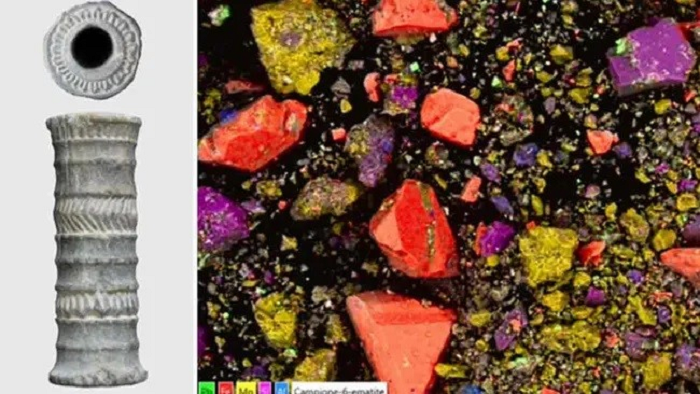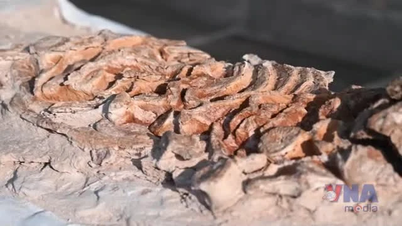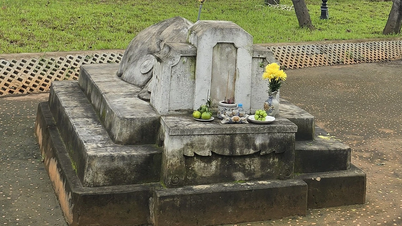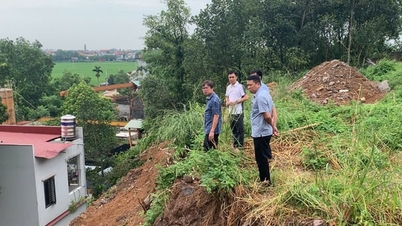Archaeologists have recovered Bronze Age cosmetics from Jiroft, a city in southeastern Iran, after the Halil River flooded and overran several nearby cemeteries dating back to the third millennium BC, according to a study recently published in the journal Scientific Reports .
The bright red substance contained inside a small stone jar may be one of the oldest known lipsticks in the world .

Bronze Age jar (left) and a microscopic image of the pigment composition, enhanced with color to distinguish individual minerals. (Source: Massimo Vidale via Scientific Reports; CC BY 4.0 DEED)
The researchers wrote in the study that the rushing water pushed the elaborately carved jar to the surface along with many other artifacts, many of which were taken by local people. The items found, including the lipstick, are now part of the collection of the Jiroft Archaeological Museum.
The oldest lipstick
To learn more about the ancient lip paint, researchers analyzed the red pigment using radiocarbon dating and determined that it was up to 4,000 years old and dated to sometime between 1936 BC and 1687 BC.
The researchers found that the pigment mixture was primarily created using crushed hematite, an oxide mineral that produces the vibrant red color, along with other minerals such as manganite and braunite. Quartz particles were also added to the mixture, either to soften the color or to add shimmer.
The lip pigment also contained traces of plant fibers, which may have been added for fragrance. The pigment itself bears a striking resemblance to modern lipstick, the authors write in the study.
Although archaeologists are not sure who owned these makeup items, they do know that these beauty products were commonly used by Iranian women during that period.
According to The Circle of Ancient Iranian Studies , a nonprofit educational program, other popular makeup products included a black powder called sormeh, used as eyeliner, and henna, used to dye hair and skin.
“This may be the oldest known example of lip varnish at the moment,” said Vidale, lead researcher on the project. “But I hope that older evidence will be identified by other colleagues.”
Source





![[Photo] Solemn opening of the 8th Congress of the Central Public Security Party Committee, term 2025-2030](https://vphoto.vietnam.vn/thumb/1200x675/vietnam/resource/IMAGE/2025/10/4/f3b00fb779f44979809441a4dac5c7df)
![[Photo] General Secretary To Lam attends the 8th Congress of the Central Public Security Party Committee](https://vphoto.vietnam.vn/thumb/1200x675/vietnam/resource/IMAGE/2025/10/4/79fadf490f674dc483794f2d955f6045)
![[Photo] Bustling Mid-Autumn Festival at the Museum of Ethnology](https://vphoto.vietnam.vn/thumb/1200x675/vietnam/resource/IMAGE/2025/10/4/da8d5927734d4ca58e3eced14bc435a3)





















































![[VIDEO] Summary of Petrovietnam's 50th Anniversary Ceremony](https://vphoto.vietnam.vn/thumb/402x226/vietnam/resource/IMAGE/2025/10/4/abe133bdb8114793a16d4fe3e5bd0f12)
![[VIDEO] GENERAL SECRETARY TO LAM AWARDS PETROVIETNAM 8 GOLDEN WORDS: "PIONEER - EXCELLENT - SUSTAINABLE - GLOBAL"](https://vphoto.vietnam.vn/thumb/402x226/vietnam/resource/IMAGE/2025/7/23/c2fdb48863e846cfa9fb8e6ea9cf44e7)
































Comment (0)